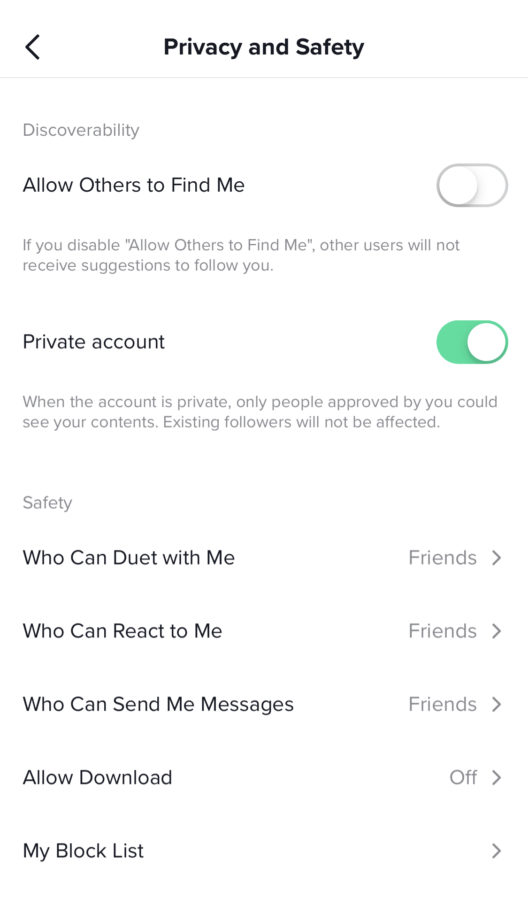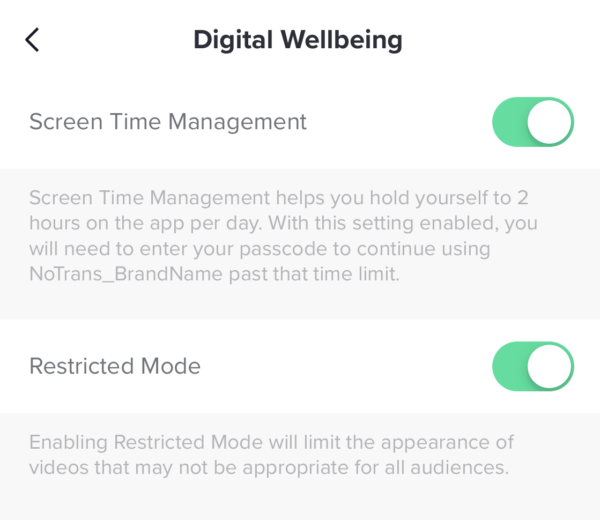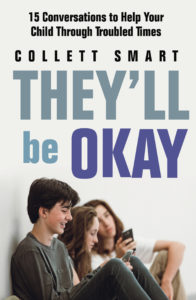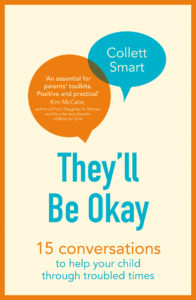Blog, Guest, Technology
by Leonie Smith

After a merger between musical.ly and TikTok, all previous users of musical.ly are now users of TikTok. There are reportedly over 150 Million users. TikTok is very much the same type of app as musical.ly was, but has a broader appeal and is not just focused on dance, gymnastics and music and vocal lipsyncing. TikTok includes a lot of prank and comedy videos and challenge style videos, where you make a video that fits a theme, i.e. #10yearchallenge or #wrapbattle.
What is TikTok about?
TikTok previously known as lip-syncing app musical.ly is a short-form 15sec video creating/sharing social media app rated 13+ for use. It is a  free mobile app available on both Apple and Android mobile devices. Users of TikTok can make videos by creating an account and using the creator tools to film their video and add special effects. They can then share videos, engage with others on the app, record duets with other users, and view videos from the “For You” tab or search for videos via search or the live streaming tab or via trending #hashtags.
free mobile app available on both Apple and Android mobile devices. Users of TikTok can make videos by creating an account and using the creator tools to film their video and add special effects. They can then share videos, engage with others on the app, record duets with other users, and view videos from the “For You” tab or search for videos via search or the live streaming tab or via trending #hashtags.
If a user posts their video publically the video can then be remixed, shared or commented on by others on the app, who may not be friends. The privacy settings (below) determine what visibility the video has and who can interact with the user or the video.
So what’s different?
- More special effects and interactive features
- Broader focus, not just dance and lip sync
- More challenges and dares, themed skits and pranks
- More interaction and collaboration on videos
- Broader demographic – more adults are making videos
- Live video streaming more prominent
Adult Content
Some content in the videos is very mature. I’ve seen videos with self-harm themes, drug and alcohol use, explicit sexual references, explicit language and lyrics, and dangerous behaviour. This adult content is easily found by simply scrolling through the “For You” feed.
Sexualised Children
There are many videos of children miming songs with explicit sexual adult language and behaving in sexualised ways.
Bullying
Bullying is still a big issue, with harassment in the comments and parody videos being created to humiliate and tease some users, particularly users with disabilities. There are quite a few videos from users calling out the bullies also.
Self Harm
Although many of the better known and more obvious hashtag search terms are hidden now, new variations of the #hashtags are created daily. I saw a lot of videos around the theme of loneliness, self-harm, and depression. I also saw some comments where people were encouraging self-harm.
Young Users
Although there seems to be an increase in adults creating videos on this app, many younger children are still using the app below the recommended age. I’ve seen children that look as young as seven years of age posting videos publicly.
In-App Purchases
Users can purchase “gifts” to give to other users. These range in price from $5.00 right up to $50.00. Popular TikTok “stars” can earn quite a bit of money through gifts. Parents can disable In-App purchases on their child’s device through parental controls which should block any monitory purchases within the app. Go to the “Screentime” settings if on an Apple device.
Adult Predators and Grooming Of Children
The live streaming side of this app has a risk of users being subjected to inappropriate comments and requests in real time. Users who are inappropriate can be reported and banned from the app or from streaming. Because live streaming is interactive, it is not advisable for younger users to live stream.
Setting up Privacy and Safety Settings – How to:
Teens should set their account to a private account and not share their videos publicly to protect themselves.
To find the privacy and safety settings go to your profile and click the … icon top right of the screen. Then scroll down to “Privacy and Safety” Set “Private Account” to the Green/On position.
You can also restrict who you can interact with you on the app via messaging or responses to your videos, set to “Friends”, or switch to “Off”.
Downloading your videos should be disabled also in the settings. Note: This setting may not prevent saving and sharing of your videos. It is relatively easy to copy videos with other screen recording methods. Making sure that all your videos are respectful and appropriate is essential.

A Safe Profile!
TikTok warns that even with a private account “your profile information – including profile photo, username, and bio – will be visible to all users. You can be sure your profile is online-ready by editing your profile page”. Please do not include personal information such as your real age, real name, school, or a link or user name for other platforms in your profile.
Adult Content Filters and Screen Time Issues
There is now a setting called “Digital Wellbeing” which can be locked with a passcode by a parent. The “Digital Wellbeing” tab has two settings, one to filter adult content “Restricted Mode” and the other setting to restrict the time on the app to 2 hours a day “Screen Time Management”.

I tested the “Restricted Mode” for adult content, and it didn’t seem to filter adult content efficiently. I still saw videos with adult content, explicit language and inappropriate behaviour with the filter enabled. From the TikTok Safety Tools Page “Enabling Restricted Mode is an option at the account settings level to limit the appearance of content that may not be appropriate for all audiences.”
Scrolling through the videos, even with the “Restricted Mode” on it is still very easy to come across adult content with, swearing, bullying, dangerous behaviour, and sexual themes. This setting is unreliable.
Screentime Setting Management – To Limit Time On The App:
There is also a new screentime limit setting to help users limit their time on the app. “With Screen Time Management enabled, we’ll help hold you to 2 hours on the app.” As a parent, you could lock it on with a secret pin code. The app will then lock up and ask for the parent’s pin code when use has reached 2 hours. There is no way to change the time limit so that it will lock up under 2 hours.
Sharing profiles across social media.
Users can share their profile to cross-promote it across to other platforms like Facebook, WhatsApp, Snapchat and Instagram. It is safer not to do this.
Last thought – Why TikTok is not a place for Tweens
The app is rated 16+ by Commonsense Media, although the app is rated on iTunes at 13+ I would agree with Commonsense Media’s assessment of 16+ preferably 13+ minimum depending on the maturity of the teen. This is due to the adult content, self-harm themes in some videos, frequent bullying, live streaming interactivity and the social side of the app. The privacy settings need to be enabled for teens and younger children, but there is no way to lock them on. Use of this app takes a mature person who can deal with bullying, possible sharing of their videos beyond their friends and inappropriate comments, random friend requests, and explicit language and adult themes.
Verdict: Definitely NOT for the under 13’s. Recommended age 16+
Leonie Smith,
“The Cyber Safety Lady”, is one of Australia’s leading Online Safety Educators. She travels around Australia, helping thousands of internet users to use the internet with more safety. Her manual, “Keeping Kids Safe Online” provides a unique Step-By-Step and up to date guide, for cyber safety settings and education.
If you would like more, Leonie is hosting a “Keeping Kids Safe Online” Webinar on Tuesday 10th March 2020 8pm Sydney Time. This is a one hour webinar for parents with insights into the latest apps including TikTok, Snapchat, Instagram, games like Fortnite and Roblox.
Additional Legal News on TikTok, from Leonie
The Chinese owners of this app ByteDance have been fined a record $5.8 Million US dollars (8 million Aus) by the U.S Federal Trade Commission for not complying with the Privacy Protection law COPPA. The reasons for the fine are that TikTok did not adhere to the law in protecting users under the age of 13+. They did not ask for age verification prior to 2017 on sign up or take down profiles of underage users who clearly stated their age on their public bios. They did not respond to parents requests to delete under age user videos and personal information. They also exposed children to predatory behaviour on the app and up until 2016 exposed users privacy giving their location within an 80K radius.
This has resulted in TikTok having to adhere to some new restrictions for U.S users. They have been told to take down U.S underage user accounts, to ask for age verification on sign up, and direct underage users to a safer version of the TikTok Platform. They must now also remove the videos of users when requested from the database. These restrictions will not cover any children based outside of the U.S. Australian children are not covered by this COPPA ruling. You can read more about the ruling and what it means here
Blog, Mental Health, Raising Teens podcast, Self-Worth
by Collett Smart

Image: Donald Tong
Part of my day job sees me lucky enough to spend time with teens. I have run media literacy seminars for students, in schools around the world, for a number of years now. Whenever I ask a group of tween or teen boys what they think the main area of body focus is, for boys, they yell out, ‘A six-pack!’ (I’ve even heard 9-year-old boys talking about and trying to compare their six-packs.) This line is the same, whether I am in Zimbabwe, New Zealand, the USA or Australia.
When given the opportunity, a whole lot more gushes out. As if a sudden crack in the wall has given them freedom to leak what’s on their minds – “Boys have body image issues too!”
Our general silence on this leads our boys to believe they are the only ones worrying. Now, they’ve finally been given permission to talk about something they are struggling with. The words come – biceps, jawlines, athletic builds, calf muscles, a broad chest, the triangular body shape, not skinny, but not too muscular, not ‘this’, but ‘that’… The boys laugh out in relief, and nod along in agreement.
Body insecurity is not just limited to our girls
What boys worry about
Boys have body image issues and are more body conscious than we realise. This is not new, but unfortunately boys are far less likely to address their own body image concerns and are more likely to struggle alone. Because body image issues have long been thought of as ‘a girl thing’. Our boys also tend to laugh off criticism or make a joke to cover up painful comments about their bodies. They carry their hurt in secret.
Boys tend to worry about how muscular they are and whether they are too skinny. Yet, when questioned directly about this, boys admit that extreme exercise and dieting are issues for both genders. Us adults are slower to recognise this as a real concern for boys.
What boys believe to be ‘good’ bodies
A UK survey reported that although most boys say that looking good won’t lead to happiness, many still believe there is a ‘perfect’ body to strive for. For boys, ‘perfect’ means muscly, lean and athletic. Boys also tend to associate muscles with being masculine. The survey also found a general naiveté among boys about when they are being advertised to, particularly through non-traditional methods such as social media. Yet, apart from their friends, this is the source with the highest influence on how boys judge themselves. Social media influences how they dress and what it means to ‘look good’.
The most fascinating aspect, to me, is that although boys say they are aware that media changes images, they tend to believe that the media changes the way women look more than men. Boys are often shocked by how much the male image has been adjusted, when it is pointed out. Some boys acknowledge that the way the media portrays men is unrealistic and unhealthy, but still say it can be inspirational.
“In this day and age, boys are expected to look their best; there is increased societal pressure placed upon them … There has recently been more of an emerging market for items that were originally almost exclusively used by girls, for example cosmetics products, hair serums and sprays, hair straighteners and body hair shavers. There is some evidence that from as young as 4 years, the pressure is being felt by children too, as some are worried about eating too much causing them to ‘get fat’.
This idea is called ‘normative discontent’. Unfortunately, it is widely acknowledged and accepted that most women experience weight dissatisfaction. However normative discontent is now more pervasive for boys as well. This is considered to be due to the strong stereotypes of how people should look.”
Sarah McMahon, psychologist and director of Bodymatters Australasia
How body focus affects boys
A US study published in 2019 found that 22% of men aged 18-24 reported muscularity-oriented disordered eating. Paediatricians are now raising concerns over the increase in muscle-enhancing behaviours (steroid abuse, binge eating and exercise dependence) in boys in particular. Essentially, there seems to be a disconnect between the actual and desired body size/shape of boys (much like we see in some girls).
We now know that muscle dissatisfaction (in boys) is significantly associated with psychological issues, alcohol and drug use, lower height satisfaction, sedentary lifestyle, poor subjective physical fitness, and lower life satisfaction.
When should I be concerned about my son?
Muscle Dysmorphia (MD) is a type of Body Dysmorphic Disorder (BDD). It is often referred to as “Bigorexia” or “Reverse anorexia” in the media and consists of a preoccupation with not being muscular or lean ‘enough’. Clinical eating disorders and MD are complex issues, with no single cause identified (and beyond the scope of this blog post). It often includes genetic vulnerabilities, psychological factors and socio-cultural influences (social media and traditional advertising are one aspect of this).
Bodymatters Australasia provides clinical guidelines on these.
In supporting our sons, we might:
1. Think about how we comment on other people’s body shape, weight or size.
My number one rule: Don’t comment on other people’s bodies – no matter how much or little they have changed. Talk about people’s character.
2. Notice how we comment on people in the media. Also, what is our own media diet like? e.g. Shows like Love Island celebrate bodies, outward appearances and hook ups as relationship markers. The objectification of men’s bodies is no different to the objectification and sexualisation of women’s. This is part of discussing media literacy to our boys.
3. Talk to boys about their emotions. Be open about boys’ and men’s insecurities. Ask men in your son’s life to speak about male vulnerabilities, men’s mental health, expressing big emotions in healthy ways, demonstrating courage in non-brawny ways too, showing love…
4. Notice (out loud) your son’s character – kindness to siblings / grandparents / strangers, courage when facing a difficult decision, helping around the house, apologies he makes. Notice what his body can DO, rather than how it looks. Notice his effort, team work and reaching his own Personal Best in sport / academics / art – not just his winning.
5. Focus on activities that get them moving, and food that is nutritious (without banning certain foods). For healthy minds and bodies – not for muscle size or shape.
6. Model body acceptance yourself. It might be time for parents to ask ourselves: How do I regard my own body? What does my child hear me say about my body? How do I talk about food and exercise in our home? When we model self-objectification boys quickly learn that only certain types of bodies are acceptable, and that appearance is what is most valued by their families.
7. Connect with your son, in ways that are meaningful to him. Let him know he is both love-WORTHY and love-ABLE
8. Use family gatherings like, meal times, traditions and holidays, to communicate a sense of family and belonging (even if he doesn’t want to talk).
9. Engage the support of male mentors. Our boys need to be invited to participate in the lives of healthy men. Rites of passage programs (like The Rite Journey) also teach boys that growing up doesn’t just involve growing muscles and genitals. Growing up looks like growing in character.
10. Encourage everyday activism. Stay in touch with what’s going on in your child’s world. Encourage teens to balance their social media feed by following positive role models, YouTubers and activist movements. Get involved with activist movements yourself. Like; Collective Shout, eChildhood, Beauty Redefined and International Justice Mission. Talk about the work they do, and explain to your sons why they are important in making changes to the body focused world we live in.
One last thought
EVERY body is valuable and important and worthy. Parents and adults, be gentle with yourselves. I know that many of us need to unlearn the destructive messages we were taught. As you support your son, learn to accept your own body in the process.

Collett Smart is a psychologist, qualified teacher, speaker and internationally published author of,
‘They’ll be Okay: 15 Conversations to help your child through troubled times’.
The heart of Collett’s work is to support and bring Hope to parents of tweens and teens. She lives with her husband and 3 children in Sydney, Australia.
Find out more at www.raisingteenagers.com.au
Here is my podcast on this topic?. Perhaps there’s a parent of a teen who really needs to hear this? Please share with them today.
I wrote more about boys and body image, in my book ‘They’ll be Okay’.
Blog, Boundaries, Guest, Risky Behaviours
by Paul Dillon (of DARTA)

Image: Maurício Mascaro
There is something both exhilarating and scary about the freedom that comes with being a teenager. Some of the teens I chat with mention how much they love going out with friends, but feel conflicted about the peer pressure around sleepovers, parties and alcohol. While some see alcohol consumption as a ‘rite of passage’, others say they feel confident enough to go to a party without having to drink. Others still, avoid sleepover parties altogether, because they don’t like the general atmosphere at alcohol infused gatherings. In each of our homes we will have teens who fit into these categories. How can we prepare our children for High School parties and sleepovers, where drinking might be involved?
As both a parent of teens/YAs and a professional working with teens, Paul Dillon is my absolute go-to expert on drugs and alcohol. I have heard him speak many times. He is engaging and humorous and most of all, up to date with the latest facts and behaviours around teens in this area. I mentioned Paul in my post, ‘Parties and Alcohol – do parents have any influence on teens?‘ Paul has also contributed to my book. Here he talks with us about sleepovers and party culture.
Why 14?
If you’re a parent of a child in Year/Grade 9 (approx 14 years old), it is incredibly important to prepare yourself for the upcoming 12 months when it comes to sleepovers, parties and gatherings. Getting things right early can prevent lots of problems in the year (and years) ahead.
The party culture begins to build in Year 9, sometimes very quickly. Although most young people at this age will choose not to drink, alcohol starts to become a part of their socialising experience, usually at pre-parties, with a small but influential group regularly drinking. Some to excess. In addition, for those of you with daughters, some more mature Year 9 girls begin to get asked out by young men a couple of years older than them to be their plus 1 (partner to an event) – More on dating here. As a result, these very young women subsequently find themselves invited to Year 10, 11 and even Year 12 events where alcohol is far more likely to be available.
When I visit schools I so often hear something along the lines of,
“We’ve got some real issues with our Year 9 cohort” and “There’s some real partying going on in that group.”
It’s usually a small group who are involved, but they’re loud, obvious and everyone knows who they are. Some can make life pretty difficult for their peers.
Parents often find themselves blindsided by this almost ‘seismic shift’ in social activity and are completely unprepared for the pressure that is applied by their child (as well as other parents), to allow them to attend events on a Saturday evening. With the beginning of the new school year it’s the Year 9 parents, particularly those who have not yet started to experience the party issue, who have most probably got the most to gain from starting the year off right.
You may not think it will happen to your child, but it is important to take a little bit of time to clearly outline your expectations. Establish some rules and boundaries, when it comes to parties, sleepovers and alcohol.
The Developmental focus
The ‘middle years’ are a great time to become clear about some of the key issues this age group will face. Year/Grade 9 is the time often referred to as ‘middle adolescence’ – the time when the search for identity becomes a central concern. Teens start to pull away from their parents and their peer group becomes even more important. They’re maturing and growing up. Many are physically changing and beginning to look much older, particularly the girls.
Growing independence
Some parents find themselves in a really difficult place. They can see that their child is growing. On one hand, they need to let their teen start to make some of their own decisions and trust them ‘to do the right thing’. Parents also want to give their child the opportunity to create their own identity and establish where they fit in the world. But, on the other hand, they want to keep them as safe as possible during this potentially very tricky time. And that involves maintaining rules and boundaries.
But, the year of the sleepover party
For many, Year 9 is the year of the ‘sleepover’ (as well as the party or gathering). Instead of making the call to host parents and dropping their teen off at the home and then picking them up afterwards, parents begin to get increasing pressure (from their child, but also friends and family members) to loosen the rules a little and let their child fly a little more. Of course, you have to trust your teen at some point, but is Year 9 the time to do it, particularly when it comes to huge sleepovers, parties and alcohol? Far from it! (Collett’s comment – Not all sleepovers have to be off limits. i.e Those between a few close friends or family friends, where parents feel comfortable might be ok with you. Paul is talking about a specific context here.)
Paul’s tips on sleepovers and parties:
1. Don’t be bullied into making decisions.
Gather the information you need to make an informed decision, and if they tell you they need to know now – the answer is ‘no’. Take your time and get it right. If both parents are on the scene, make it clear that both of you make decisions around sleepovers and parties. Teens are extremely clever at setting up one parent against the other and it is vital that you display a ‘united front’ here. Make it clear by telling them – “Don’t come to me, don’t go to them – come to us!”
2. Know where your child is and who they are with.
No parent likes to hear this (and many refuse to believe it) but at this age some teens are likely to start lying about where they are planning on going. If you want to let it slide, that’s up to you, but you’ll never forgive yourself if something terrible happens. At this age you should still take your teen to where they’re going and pick them up. Don’t leave it up to someone else, if you can possibly help it.
3. Always call the host parents.
Speak to them and find out some basic information about supervision and whether alcohol will be provided or tolerated. Your teen is not going to like this and they’ll most probably tell you that you’re ruining their life – but that’s your job! If they tell you that they hate you – respond with,“But I love you …”
4. Create rules and consequences and stick to them.
If you haven’t done this already, the beginning of Year 9 is a great time to have a family discussion about the rules you have around parties and alcohol. The consequences of breaking those rules should also be clearly laid out and agreed to by your child. They can’t say they’re unfair later if they’ve agreed to them. Most importantly, if you don’t follow through, should a rule be broken, it makes it all the more difficult to set boundaries the next time The first time you buckle and let something slip, you will lose your credibility and your rules will become totally ineffective. (Collett’s note – all is not lost however. It will just take a little longer for your teen to learn that you will follow through on boundaries broken. And you may be tested for a while.)
5. If they don’t like the rules, they’re most probably perfect.
But remember, reward good behaviour and modify the rules as they get older to make sure they’re age appropriate (see ‘Choose your battles’ below).
6. If things start to get out of control, get help.
Too often parents leave it too long to seek help when things go wrong. If your teen is climbing out of the window on a Saturday night and not coming home, that is not normal behaviour. You can always start with the school counsellor, or even your GP, but make sure you talk to someone. Get professional advice if things start to get too difficult.
Choose your battles
With teens of this age, it is also incredibly important to ‘choose your battles’. You and your partner need to identify what your ‘non-negotiables’ are (i.e., those things you won’t compromise on) and spell them out clearly to your teen. They are often behaviours related to safety and wellbeing.
If you fight with your teen about everything, your life (and relationship with them) will become very difficult. If you let the things that really don’t matter (i.e. have nothing to do with personal safety and more to do with your personal disappointment, e.g., “You’re not going out dressed like that!”) slide once in a while, you’ll find yourself having a much easier time. Yet, if your 14-year-old wants to sleepover at someone’s house or go to a party and you don’t think that it will be safe, this is where you do stick to your guns, and the rules and boundaries do come into play. When you have made the decision that you’re not going to give your permission, say ‘no’, make it clear why you’re saying it and don’t back down!
One last thought
It’s not all about saying ‘no’ to everything. This is not about being strict or oppressive. Letting a 14 year old have a win occasionally can make family life so much more pleasant. If you want a warm and positive relationship with your teen, particularly in the middle years, you need to always be on the lookout for opportunities to allow your child to do something. If it looks safe and you feel comfortable – say ‘yes’! Wrapping them up in cotton wool and saying ‘no’ all the time is not healthy either.
Raising Girls, Raising Teens podcast, Relationships, Resilience
by Collett Smart

Photo by Sebastian Voortman
When I worked as a school psychologist, for more than 10 years, some of the most common lunch time chats I had in my office were with one girl or a group of girls. Inevitably, because something had ‘gone wrong’ in their relationships. This resulted in some tears, sometimes heartache, often internal wrestling or questioning.
Girlhood relationships are so important, yet they can be both wonderful and awful in the same week. This seems to really ‘ramp up’ for a period, in the tween and early teen years. Friendship fallouts hurt, but children need to know that arguing doesn’t have to be the end of the friendship. Developmentally, some squabbling is vital because it helps us learn respectful conflict resolution.
What can we do, when friendships go wrong for girls?
1. Handling disagreements
When inevitable conflict arises, girls can often get caught in a ‘rumination loop’ – they replay the scene over in their minds, like a sad song stuck on repeat, which makes things feel catastrophic. Because your daughter’s brain is still learning how to interpret some responses, and she may be misinterpreting a friend’s words or signals, ask her to look for evidence to support her interpretation. There are certainly times when she might be oversensitive. Whether she finds evidence or not, if she still believes something is wrong, suggest your daughter talk to her friend privately and in person – without an audience. In a manner that is assertive rather than aggressive. Help her plan or role play beforehand, so that she understands what assertiveness looks and feels like.
Help her start with ‘I’ words, which encourage girls to own their feelings. She could say,
‘I felt let down when…’ or ‘I was disappointed when…’
If your daughter realises that she also caused pain, help her think of ways to say,
‘I’m sorry. Can we fix this?’
And of course, the best thing we can do is model apologies at home.
2. Stay out of it
Nothing brings out the mama-bear more than a parent knowing their child is in emotional pain. However, unless there is clear bullying going on, (where you might need to try different strategies) it is better to stay out of the conflict yourself. It is very unwise to confront the other girl yourself. Also, avoid calling up the other party’s parent when you feel frustrated. So often, the girls get over their conflict and are BFFs again by Friday, while the adults are left nursing hurts and regrets for things said.
There are certainly times when parents decide to chat together, about helping their girls work through conflict in healthy ways. For example, one way to avoid the ‘audience’ might be to drive your daughter across to her friend’s house, where they can talk in private. You could agree to sit in the car or chit-chat with the other parent, while the girls work through their issue alone.
3. Shifting friendships
Although painful, not all relationships are meant to continue forever. As girls grow they shift from being little ones, reliant on parents, to becoming more independent. Their tastes and interests change. They want to explore the possibilities of new groups and activities. This often leads to hurt when one girl is not ready for a shift.
Parents might also normalise that changes in friendships are a part of growing up (although never an excuse for meanness). Rather than simply dismissing your daughters’ feelings as silly, acknowledge the hurt and gently reassure her. There are many new, interesting people she will meet throughout her life.
If your daughter chooses to move groups or change BFFs, talk with her about kindness and avoiding complete exclusion of others. Ask her to think about how she might feel if she were in the other person’s place and what she might do to deal with others sensitively.
Toxic ‘friendships’ and bullying
Most girls will experience the pain of interacting with a toxic ‘friend’ during their school years. This type of interaction often involves ‘relational aggression’ and serves to damage a person’s sense of social place. E.g. a girl appears to be friendly but uses passive-aggressive strategies – gossip, belittling, exclusion online, on the bus, from parties or seating arrangements. This can be very confusing, and leads to feelings of shame and loneliness.
When not given healthy ways to express their pain, girls can often internalise their emotions in unhealthy ways like; self-harm, anxiety, eating disorders, self- loathing etc.
Allow your girls to express their hurt
Adults need to be a safe place for girls to process pain, vent or cry when they are hurting. Adults may not be able to change the toxic person’s behaviour at the time, but shouldn’t underestimate the power of listening and being available. Try not to assume you know what your daughter needs. A good phrase to use is,
“What do you need from me to feel supported in this situation?”
If it becomes clear to you that there is bullying, it is time to chat with the school, coach or youth leader. Girls will often beg their parents not to ‘tell’. But your daughter’s mental health and self-worth are eroded by bullying. Doing ‘nothing’ is not an option. Gently reassure her and include her in strategies – but make changes.
Bullying. NO WAY!, includes the national definition of bullying:
Bullying is an ongoing and deliberate misuse of power in relationships through repeated verbal, physical and/or social behaviour that intends to cause physical, social and/or psychological harm. It can involve an individual or a group misusing their power, or perceived power, over one or more persons who feel unable to stop it from happening.
Bullying can happen in person or online, via various digital platforms and devices and it can be obvious (overt) or hidden (covert). Bullying behaviour is repeated, or has the potential to be repeated, over time (for example, through sharing of digital records).
Bullying of any form or for any reason can have immediate, medium and long-term effects on those involved, including bystanders. Single incidents and conflict or fights between equals, whether in person or online, are not defined as bullying.
Expand her village
I often remind parents and teens that adults’ closest friends are not usually work colleagues. You daughter doesn’t have to be super close with school friends. It can help to think of peers at school, like work colleagues. As long as they are not completely alone or isolated at school, this can be freeing for some girls.
Ensure your daughter has friends in a few settings – a neighbour, a team mate, a family friend, a band member, someone at youth group… They can provide a different connection and help girls realise they are not alone. Girls often find their tribe, when they belong to other organisations outside of school.
One last thought on growth opportunities
Help girls to think about what they value in friendship. Brainstorm by using sentence starters like,
‘A good friend is a person who …’
Encouraging girls to develop skills for dealing with friendships, provides them with something they will use throughout life. Explicitly teaching your daughter to think about what compassion, kindness and empathy look like in a friend, helps her recognise what it means to be a good friend herself.
Please support or encourage a parent, by sharing this article with them.
If you would like to hear my webinar on this topic, please head across to Parenting Ideas.
Info for supporting both boys and girls with friendship struggles can be found here, on my podcast ‘Raising Teens’:
Collett Smart is a psychologist, qualified teacher, speaker and internationally published author. The heart of Collett’s work is to support and bring Hope to parents of tweens and teens. She lives with her husband and 3 children in Sydney, Australia. Find out more at
www.raisingteenagers.com.au
Adapted from Conversation #2 Emotional Intelligence: ‘You don’t have to be happy all the time’, in Collett Smart’s book ‘They’ll Be Okay: 15 Conversations to help your child through troubled times.’ (Hachette)
Blog, Raising Teens podcast, Relationships
by Collett Smart

Photo by Tim Mossholder
One thing that continually strikes me about the young people I work with is that they really do want to become good men and women who have rich, meaningful relationships. They are just sometimes unsure how to go about it. They need our support and guidance.
We are made for relationships
What young people everywhere have in common is the need for love – in some ways, they crave it as much as (or even more than) basic needs like food. I believe we are made for relationships. In my opinion, developing Relationship Intelligence and Emotional Intelligence are the most vital skills we can teach our children. Above IQ (although I am not suggesting we pull our kids out of school!).
In my book, I mention the 80-year landmark study on men’s relationships and wellness, which supports this view. It revealed that early fame, wealth and high achievement don’t bring happiness. The study concluded that social connections are really good for us.
Basically, people who are more connected to family, to friends, to community are happier, physically healthier and live longer. While lonely people are less happy, their health declines earlier in midlife, their brain functioning declines sooner, and they live shorter lives than people who are not lonely. Other studies also show that a lack of social connection is more detrimental to health than obesity, smoking or high blood pressure. In general, people who feel more connected to others have a higher sense of self-worth, possess greater empathy, and are more trusting and cooperative.
In his TED Talk based on the above study, psychiatrist Robert Waldinger concludes,
‘Good relationships keep us happier and healthier, period.’
Hence, if relationships are good for their health, bring lasting meaning and also develop resilience, perhaps it is time we focused more of our attention on teaching our young people about RI – Relationship Intelligence.
It is important to note that it is not the number of friends your teen has. It also doesn’t matter whether they are in a romantic relationship or not. What matters is the quality of their close relationships.
My two Relationship Intelligence (RI) categories
I believe there are two broad categories of Relationship Intelligence. These are;
- a relationship with the self (not as self-centred as it sounds). i.e. Knowing you are love-WORTHY.
- our relationships with others. i.e. Knowing how to be love-ABLE.
Essentially, the former encourages self-respect and the latter develops an ‘other-respect’.
I don’t mean that we need to name the two categories every time we have a conversation with our teenagers. They are more a frame of reference, to keep in our minds as we raise Relationally Intelligent teens. i.e. If we frame our RI conversations in terms of these two categories, it becomes easier for us to formulate our own thoughts and to communicate our family values. It can help us think about how we treat our teenagers, how to talk about sibling disagreements and friendship issues. When tricky topics (like p*rnography or bullying) are part of the Relationship Intelligence dialogue, it can make talking about them seem a little easier.
The two categories help us to think about the ‘why’ behind the values or behaviours we teach our teens.
In the day-to-day
For teens to build healthy relationships requires the adults in their lives to make use of effective communication skills and age-appropriate boundaries.
Love-WORTHY teens
This is about teaching teens to understand that they are worthy of love. It is not about arrogance or conceit. It’s learning that they are enough. Just as they are. Loved. Unconditionally.
When teens learn this they begin to practise self-compassion and self-care. Teens develop the courage to speak up when they are not treated with dignity. Love-WORTHY teens learn to look after their minds and bodies by; getting adequate sleep, exercising and eating well (they may need a little – ahem firm – nudge on some of these still). And their positive self-talk improves.
Our teens develop a sense of self-WORTH when we:
- encourage them to grow skills through; doing chores, engaging in extracurricular activities, part-time jobs or completing school tasks
- help them to find a group where they can feel they belong (sport, art, drama, music, youth groups, part-time jobs can help with this)
- allow them to believe they have a voice, by listening to their ideas and engaging in respectful arguments or debates
- have high but reasonable expectations of them
- let them earn some independence and try things on their own
- allow them to fail and then learn that it has not crushed them
- acknowledge their emotions without belittling or dismissing them
- love them unconditionally, even when they mess up – “I know you have to face the consequences for X, but I am always here for you and nothing will change my love for you.” or “I don’t love you any less because you failed your Maths test.”
- apologise to our teens when we mess up (this is modelling)
- tell them when we are proud of and notice their developing character – “I noticed how kind you were to your sister earlier. You are growing into such a wonderful man.”
- communicate, in every way we can, that they are ‘enough’ to us! Just the way they are. They don’t need to earn our love.
Love-ABLE teens
Teaching teens that they need to also be love-ABLE instils in them a recognition of the worth of others. They realise that others are also deserving of compassion and kindness. Love-ABLE teens learn that their choices have an impact on other people. Which means, at times, they will have to experience a consequence for hurting others. Love-ABLE teens change their behaviour when they realise that their actions might negatively affect another person. They are also better equipped to speak out when they see others being mistreated.
Our teens develop a sense that they are love-ABLE when:
- they have chores to do (yes it really does make a difference to character). Even when they don’t feel like doing them
- they are expected to attend a match, because they committed to the team, even though going to a movie seems more fun
- facing consequences for behaviour that affects someone else
- we expect our teens to take some action to change poor behaviour
- they sacrifice something they really wanted to do, for someone else’s happiness. e.g. Attend a siblings basketball final instead of going to the beach with a friend)
- again – we allow them to believe they have a voice. e.g. When they want to stand up for injustice
- they engage in volunteer activities (coaching a younger team, taking out a neighbour’s bin, leading a youth group)
- teens practice gratitude (verbally, in writing or via text message/email ). e.g. Thanking a coach, a family member or teacher for their time or effort.
- apologising or making right
- we call out the times we notice their kindness to others
- parents or teachers thank them for something they have done or said
- (adults don’t expect all of these at once)
It’s important to find a balance between these two categories, because if we teach our children to be only love- ABLE, they become vulnerable to abuse and exploitation through others’ selfishness. And if we teach them to only to think they are love-WORTHY, they are likely to develop self-centred and narcissistic-type thinking.
We are in this for the long haul
They watch us. How we respond to their other parent or their siblings. How we interact with the lady at the grocery store. What we say about Grandpa. If we smile and greet the person with a disability. Whether we can apologise and make right, when we’ve messed up in any of the above. They watch us.
Connection matters
Teens learn relationship values from the adults they spend the most time with. In both the day-to-day joys and the struggles. Naturally, forging connections with teens is the same as for anyone – they need our TIME. This is not a new secret in terms of how to relate to children. Spending time with and meeting teens where they are at is crucial to their healthy development. Despite what we hear about teenagers, even when they push us away, they need our time just as much as they did when they were 5 years old. Just in different ways.
There are positive associations for teens who spend an average of six hours a week engaged in family time with their parents. The more time teens spend in family time – such as during meals, having a parent watching them play sport, driving to guitar lessons, attending Grandma’s birthday, popping up to the shop together, on holidays, chatting after a party – the less likely they are to abuse drugs and alcohol and engage in other risky or illegal behaviour. (Note: I didn’t say 6 hours of eyeball to eyeball time – so please breathe easy).
To encourage you – many parents (even working parents) are spending more time with their children than in past generations.
One last thought
If it is true, that relationships are good for their health, bring lasting meaning and also develop resilience, then let’s think of ways we can develop Relationship Intelligence in our teens’ lives. It will look different in your family and in mine, because our relationships are different. That’s the messiness, the beauty and the mystery of it all.
Here is my podcast on this topic:
Please support or encourage a parent, by sharing this article with them.

Collett Smart is a psychologist, qualified teacher, speaker and internationally published author. The heart of Collett’s work is to support and bring Hope to parents of tweens and teens. She lives with her husband and 3 children in Sydney, Australia. Find out more at
www.raisingteenagers.com.au
Blog, Education, Guest
by Michelle Mitchell

My colleague, Michelle Mitchell, is a an educator and parenting author. Here she talks with such honesty, about the transition (for parents and young adults) from high school to the world beyond… and when you suddenly have a young adult with bold Ideas
My young adult with bold ideas
12 months ago my son came to my husband and I with an “idea”. Year 12 was finished. The safety of school was over. Schoolies was done. He was faced with the big decision of what to do with 8 hours, five days a week. It was time to adult. But he was a young adult with bold ideas.
“I want to start a film and photography business,” he said, completely out of the blue.
With slightly raised eyebrows my husband and I said, “Why don’t you go to university and study film, work for someone for a few years and then start a business from there?”
It sounded completely logical to me, but we didn’t get much enthusiasm back.
“I don’t want to study. I want to make film,” he insisted.
The discussion continued as we talked about building a strong foundation for life, the importance of life experience, the real pressure of business and the fact that he didn’t have a dollar to his name.
Still no love back. We weren’t winning.
I was looking for flaws in my argument, but I couldn’t find any. The only thing I could find was a child who insistently knew better. He was sure of himself and the future he wanted to create.
For anyone out there thinking, “What is she complaining about?? That is wonderful!!!” I DO AGREE. HOWEVER, I’d like to be very honest in an attempt to help parents who might find themselves in the same headspace. The idea of a 17-year-old running a business sounded a lot more wonderful when it was someone else’s child. When it was my academically capable 17-year-old who I thought should pursue a degree (or some work experience) it got a little more real.
As parents we think a lot. I thought about all my son’s options. I thought about how tough business was. I thought about everything he didn’t know about invoicing and insurance and time-management. I thought about the time he might be wasting while others were ‘getting ahead’. I thought way too much, and then wrapped it up in a bow and gave it to my son to unpack.
So, what happened next?
My dear son respectfully went against almost all of my well-intended advice. He listened, and then chose to reject it WITH my full blessing.
I had to accept that my son was amongst the small percentage of kids who have entrepreneurship in their blood. They like pressure. They thrive when the chase is on. They want to run their own course. They might succeed or fail valiantly, but they will do it on their own terms.
It would have been very easy to force or manipulate him into taking a more traditional route. I was tempted to do both. When I saw my son wobble and stumble I wanted to mention that perhaps a ‘normal’ job would serve him better, but I had to refrain from stepping in. I realised pretty early on that if I didn’t embrace his adventure, or if I tried to put someone else’s journey on his shoulders, he would lose himself.
What Have I Learnt About Championing Uniqueness?
It can be hard, especially when we think we know better. As a parent, I prided myself on knowing my two boys. This type of knowing has served me well in previous years. However, as they have become young adults, the ability to NOT KNOW has been my greatest blessing. Not knowing has allowed me to step back, and observe the adult which is emerging.
Practically How Did I Do This?
These are the five things which have been critical in helping me firstly accept, and then support my son’s dreams:
1. Connecting with the “Why”
I speak to so many young people, my son included, who believe that you don’t need a degree to build a career. The “work from anywhere” mentality has captured their imagination, and the internet has given them the thumbs up to pursue their dreams on their terms. This generation of entrepreneurs are built to create change in their world. They think differently. They move differently. They are very connected to the cultural climate around them. The more we can invest into the “why” that motivates our kids to create, the better equipped they will be to know how their gifts can make a difference in the world. When the going gets tough, “why” is the only thing that will carry them through.
2. Finding the Right Fit
It takes time to discover where ideas connect and resonate and become financially viable, so get ready for a lot of changes. From the outside watching someone start a business it can look like chaos, but there is so much processing happening behind all the commotion. If your son or daughter is creative they will be forever coming up with great ideas, failing, coming up with another idea and the journey continues. That’s a good thing. Being supportive of change, decision making, stepping forward and risk taking will only empower them. Our saying is, “Keep what is working. Throw out the rest. Don’t talk about it. Change it.”
3. A Business Not a Hobby
This is an interesting one! Market reality is a real lesson that all creatives NEED to learn. Financial viability gives an indication of whether their gifts are resonating with people. Cash is king, and there is a difference between a business and a lifestyle business or hobby. In my opinion, realistic goals should be something that young adults should be accountable to, especially if parents are supporting them financially. We have set monthly financial targets with my boy, to help keep him on track. We certainly don’t hold these over his head, but we work towards them together.
4. I Won’t Pick You Up
As parents, our hearts and minds are fully supporting our kids. I am sometimes annoyingly ‘involved’ in my son’s daily accomplishments. However, one of the things my husband and I have clearly said to our son is, “We will not financially pick you up (at all) but we will give you a safe place to fall.” I am not offering any loans or get-out-of-jail-free cards. (Some are surprised at this.) I don’t think he needs a loan to start a business. In fact, I think it would only be a hinderance to him. I will put a roof over his head and feed him at night. Business is tough, and I don’t want to shelter him from that.
5. Walk the Fine Line Carefully
As exceptional as being in business at 17 sounds, it also comes with its challenges of knowing when and how to ask for help. Not a “come and rescue me” type of help, but an “I have a very specific question” type of help. And when it comes to answering those questions, I have found there is a very fine line between taking over and offering a practical support. We ultimately want to help them fine-tune their ears to their inner voice. Try questions like: What options are you considering? Is there information you are missing? Who might have done this before? What is the next best step forward? How is this different or the same as past experiences? Can you reduce the risks? Do you need a back-up plan?
Final Thought
Occasionally it’s good to be proven wrong.
After 12 months my adventurous boy has successfully built a ‘baby’ business. He is paying his own way, doing what he loves. And although there is still much growing to do, it is clear that he is walking his destined path. And this mum has learnt to pick up her pom-poms and enjoy the show.
Michelle is an award-winning speaker, author and educator. She lives with her husband and two sons, in Brisbane, Australia. Find her at
www.michellemitchell.org
 free mobile app available on both Apple and Android mobile devices. Users of TikTok can make videos by creating an account and using the creator tools to film their video and add special effects. They can then share videos, engage with others on the app, record duets with other users, and view videos from the “For You” tab or search for videos via search or the live streaming tab or via trending #hashtags.
free mobile app available on both Apple and Android mobile devices. Users of TikTok can make videos by creating an account and using the creator tools to film their video and add special effects. They can then share videos, engage with others on the app, record duets with other users, and view videos from the “For You” tab or search for videos via search or the live streaming tab or via trending #hashtags.
















 My name is Collett Smart. I am a psychologist, qualified teacher, speaker, podcaster and internationally published author, with more than 25 years experience working in private and public schools, as well as in private practice. I am married and have 3 children aged aged 22, 20 and 14 years-old.
Welcome to Raising Teens!
My name is Collett Smart. I am a psychologist, qualified teacher, speaker, podcaster and internationally published author, with more than 25 years experience working in private and public schools, as well as in private practice. I am married and have 3 children aged aged 22, 20 and 14 years-old.
Welcome to Raising Teens!